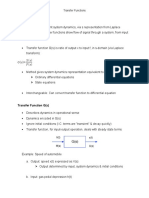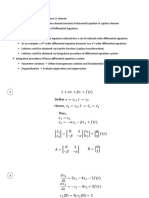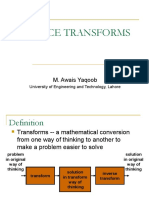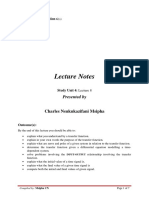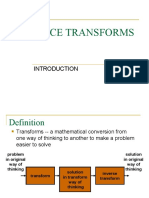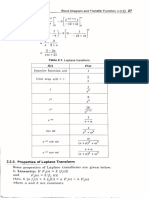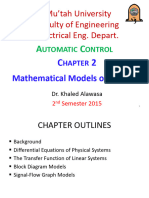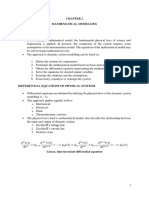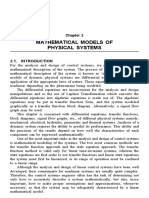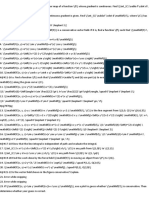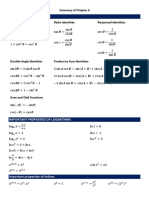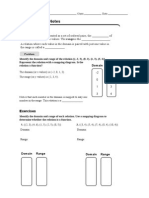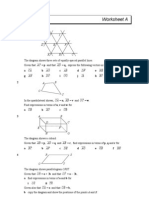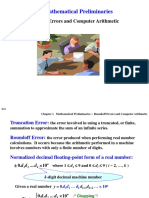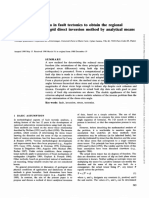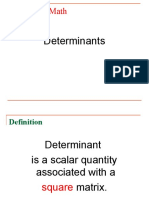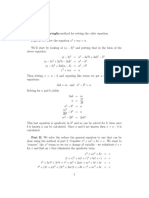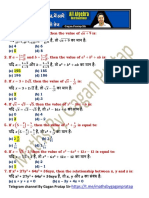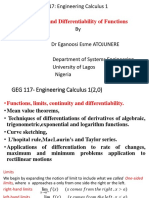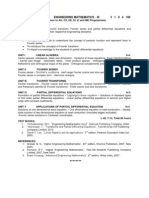Laplace TransferFunctions
Uploaded by
Hera-Mae Granada AñoraLaplace TransferFunctions
Uploaded by
Hera-Mae Granada AñoraM.D.
Bryant ME 344 notes 03/25/08 1
Laplace Transforms &
Transfer Functions
Laplace Transforms: method for solving
differential equations, converts differential
equations in time t into algebraic equations
in complex variable s
Transfer Functions: another way to represent
system dynamics, via the s representation
gotten from Laplace transforms, or excitation
by est
M.D. Bryant ME 344 notes 03/25/08 2
Laplace Transforms
Purpose: Converts linear differential equation
in t into algebraic equation in s
• Forward transform, t → s: f(t) ⇒ F(s)
∞
F(s) = ⌡ f(t) e- st dt = L {f(t); t → s }
⌠
t= 0
Convergence/existence of integral:
|f(t)| < M e- at , a + Re(s) > 0
so that e-[a + Re(s)]t finite as t → ∞
• Inverse transform, s→ t: F(s) ⇒ f(t)
c+j∞
1
⌡ F(s) e st ds = L {F(s); s→ t }
⌠ -1
f(t) = 2πj
ω= c- j∞
Integral in complex plane, rarely do
M.D. Bryant ME 344 notes 03/25/08 3
Procedure:
• Convert Linear Differential Equations
x˙ = Ax + f (t)
dxn
d x dx n"1
dx 2
+a +!+ a +a + a x = f (t)
dt dt dt dt
n n"1 n"1 2 2 1 0
in time t into algebraic equations in
complex variable s, via forward Laplace
! transforms:
X(s)=L {x(t); t → s }, F(s)=L {f(t); t → s }
• Solve resulting algebraic equations in s,
for solution X = X(s)
• Convert solution X(s) into time function
x(t), via inverse Laplace transform:
x(t) = L-1{X(s); s→ t }
M.D. Bryant ME 344 notes 03/25/08 4
Example: Solve initial value problem,
differential equation with initial condition:
2
˙x˙ + 2 ζ ωn x˙ + ωn x = Ho us(t)
x(0) = xo , x˙ (0) = x1
• Apply Laplace transform
∞
L= ⌠⌡ { . } e- st dt to all terms in equation:
t= 0
# # #
$
t= 0
x˙˙(t)e dt + $ 2%& x˙ (t)e dt + $ & x(t)e dt
" st
t= 0 n
" st
t= 0
2
n
" st
∞
= ⌠
⌡ Ho us(t) e- st dt
t= 0
• factor constants and apply definition for
! us(t) :
∞ ∞
⌠
2
d x - st ⌠ dx 2 ∞
e dt + 2ζω e- st dt +ω ⌠ ⌡ x e- st dt
⌡ dt 2 n ⌡ dt n
t= 0 t= 0
t= 0
∞
= Ho ⌠
⌡ e- st dt
t= 0
M.D. Bryant ME 344 notes 03/25/08 5
∞
• Define X(s) = x(t) e- st dt
⌠
⌡
t= 0
• Integrate by parts
∞
dx - st ∞ dx - st
⌠
- st ∞
dt e |t=0 +s
dt
⌡
e dt +2 ζωn {x(t) e |t=0
t= 0
∞ 2 ∞
⌠
+s x(t) e
⌡ - st dt } + ωn X(s) = H e- st|t=0 O
t= 0 ("s)
• Rearrange, note lim e = 0
t "#
$ st
- x˙ (0) + s (- x(0) + s !
X(s) ) + 2ζωn {- x(0) +
2 Ho
s X(s) } + ωn X(s) = s
!
Note: L {dx/dt} = - x(0) + s X(s)
L {d2x/dt2} = L {d x˙ /dt} =- x˙ (0) + sL {dx/dt}
• Result: algebraic equation in s
! ! =
H
(s + 2"#
2
s +# 2
)X(s) O
+ x + (s + 2"# )x
s
n n 1 n 0
Note: x˙ (0) = x1 , x(0) = xo
!
M.D. Bryant ME 344 notes 03/25/08 6
• Solve
Ho
s + x1 + ( s + 2 ζ ωn) xo
X(s) = 2
2
s + 2 ζ ωn s + ω n
• Note:
o characteristic equation in denominator
o terms from initial conditions x1 ,
H
xo grouped with excitation term O
!
M.D. Bryant ME 344 notes 03/25/08 7
• Apply inverse Laplace: x(t) = L-1{X(s); s→ t }
2
Ho ωn
x(t) = 2 L { -1
2 }
ωn s (s2 + 2 ζ ωn s + ωn)
2
xo s ωn
+ 2 L { -1
2 }
ωn s2 + 2 ζ ωn s + ωn
2
x1 + 2 ζ ωn xo ωn
+ 2 L {
-1
2 }
ωn s2 + 2 ζ ωn s + ωn
o Use Laplace transform tables for L-1:
Ho e-ζ ωn t sin(ωn 1 - ζ2 t + arccos ζ )
x(t) = 2 {1 - }
1 - ζ2
ωn
2 -ζ ω t
xo ωn e n sin(ωn 1 - ζ2 t - arccos ζ )
+ 2 {- }
1-ζ2
ωn
x1 + 2 ζ ωn xo ωn e-ζ ωn t sin(ωn 1 - ζ2 t )
+ 2 { }
1-ζ 2
ωn
M.D. Bryant ME 344 notes 03/25/08 8
Transfer Functions
• Method to represent system dynamics, via
s representation from Laplace transforms.
Transfer functions show flow of signal
through a system, from input to output.
• Transfer function G(s) is ratio of output x
to input f, in s-domain (via Laplace trans.):
X(s)
G(s) =
F(s)
• Method gives system dynamics
representation equivalent to
! Ordinary differential equations
State equations
• Interchangeable: Can convert transfer
function to differential equations
M.D. Bryant ME 344 notes 03/25/08 9
Transfer Function G(s)
Describes dynamics in operational sense
Dynamics encoded in G(s)
Ignore initial conditions (I.C. terms are
“transient” & decay quickly)
Transfer function, for input-output
operation, deals with steady state terms
h(t) x(t)
G(s)
H(s) X(s)
Example: Speed of automobile
o Output: speed x(t) expressed as X(s)
o Output determined by input, system
dynamics & initial conditions
o Input: gas pedal depression h(t)
o Dynamics: fuel system delivery,
motor dynamics & torque,
transmission, wheels, car translation,
mass, wind drag, etc.
o Initial conditions’ (initial speed)
influence on current speed
diminishes over time, thus ignore
M.D. Bryant ME 344 notes 03/25/08 10
Transfer Function Example: 2nd order
system
• Differential equation at steady state (can
ignore initial conditions)
2
˙x˙ + 2 ζ ωn x˙ + ωn x = h(t)
• Apply Laplace transform, define
X(s) =L{x(t); t → s}, H(s) =L{h(t); t → s }
• Result: algebraic equation
2
(s2 + 2ζωn s + ωn )X(s) = H(s)
• Transfer function G(s): ratio of output
X(s) to input H(s)
X(s) 1
G(s) = H(s) = 2
s2 + 2 ζ ωn s + ωn
• Note:
o characteristic equation in denominator
o denominator roots => eigenvalues
o transfer function’s eigenvalues called
poles
M.D. Bryant ME 344 notes 03/25/08 11
Example: First order system
"x˙ + x = f (t)
• Apply Laplace transform, define
X(s) =L{x(t); t → s}, F(s) =L{f(t); t → s }
L{τ x˙ ; t → s} +L{x(t); t → s} =L{f(t); t → s }
!
• Result: algebraic equation
sτX(s) + X(s) = F(s)
• Transfer function
1
G(s) =X(s)/F(s) =
"s +1
• Note:
o characteristic equation in denominator
o transfer function’s eigenvalues = poles
o p1 = λ1 = - 1/τ
!
M.D. Bryant ME 344 notes 03/25/08 12
Transfer Function from State Equations
• Matrix form
x˙ = Ax + f (t)
• Explicit equation form
n
x˙ = " a x + f (t)
k
j=1
jk j k
! • Define
Xk(s)=L {xk(t); t → s }, Fk(s)=L {fk(t); t → s }
! • Apply Laplace transform
sX(s) = AX(s) + F(s)
or
n
sX k
(s) = " a jk
X (s) + F (s)
j k
! j=1
!
M.D. Bryant ME 344 notes 03/25/08 13
• Rearrange matrix form:
[ sI " A] X(s) = F(s)
• Solve, via Cramer’s rule:
det{[ sI " A] }
! X (s) = kth column replaced by F ( s )
det[ sI " A]
k
• Transfer function, define which output
Xk(s) and which input Fj(s):
! X (s)
G (s) = k
F (s)
kj
• Solve, via previous result with all
components of F(s) zero, except Fj(s)
!
M.D. Bryant ME 344 notes 03/25/08 14
Example: differential equations
from transfer function:
X(s) 2s + 5
G(s) = =
F(s) s + 3s + 2s + 2s +1
4 3 2
Cross multiply ratios:
! ( s + 3s + 2s + 2s +1) X(s) = (2s + 5) F(s)
4 3 2
s X + 3s X + 2s X + 2sX + X = 2sF + 5F
4 3 2
Treat: s => d/dt
!
! d4 x d3x d2x dx df
4
+ 3 3
+ 2 2
+ 2 + x = 2 + 5 f (t)
dt dt dt dt dt
!
M.D. Bryant ME 344 notes 03/25/08 15
Block Diagrams
h(t) x(t)
G(s)
H(s) X(s)
• Another way to represent system
dynamics pictorially
• Weakness: lacks causality information
• Shows signal flow through system
• Transfer function G(s) inside block
• Output:
X(s) = G(s) H(s)
transfer function times input H(s)
• Can assemble blocks into system model:
M.D. Bryant ME 344 notes 03/25/08 16
• Cascaded Blocks
H(s) X1(s) X2(s) X(s)
G1(s) G2(s) G3(s)
• Output = input to next
• Models “stringing” of components
M.D. Bryant ME 344 notes 03/25/08 17
• Example: stereo system
speaker
CD player amplifier
CD player→ amplifier→ speakers
X (s)
CD player: G (s) = 1
H (s)
1
• Input: H(s) from CD laser
reader
• Output: CD voltage X1(s)
! X (s)
Power amplifier: G (s) = 2
X (s)
2
• Input: CD output voltage X1(s)
• Output: amp voltage X2(s)
X(s)
Speakers: G (s) =
! 3
X (s) 2
• Input: amp voltage X2(s)
• Output: sound, acoustic
pressure X(s)
!
M.D. Bryant ME 344 notes 03/25/08 18
H(s) X1(s) X2(s) X(s)
G1(s) G2(s) G3(s)
• Overall transfer function is product of
block transfer functions:
X(s) X(s) X (s) X (s)
G(s) = = = G (s)G (s)G (s)
2 1
H (s) X (s) X (s) H (s)
1 2 3
2 1
Note:
X (s) X (s)
G (s) = 1
, G (s) = 2
,
H (s) X (s)
1 2
X(s)
G (s) =
X (s)
3
! !
!
M.D. Bryant ME 344 notes 03/25/08 19
Example
H(s) 3 2s !1 X(s)
s +1 s + 4s +1
2
• Transfer function:
X(s) 3 2s #1
G(s) = = G (s)G (s) = "
H (s) s +1 s + 4s +1
1 2 2
3(2s "1) 6s " 3
G(s) = =
(s +1)(s + 4s +1) s + 5s + 5s +1
2 3 2
• Poles = roots of denominator (values of s
such that transfer function becomes
infinite)
p1 = -1, p2,p3 = -2 ± √3
• Zeros = roots of numerator (values of s
such that transfer function becomes 0)
z1 = 1/2
M.D. Bryant ME 344 notes 03/25/08 20
Summer (Summing Junction)
X1(s)
-
X2(s) + X(s)
+
X3(s)
Output = sum of inputs
Sign on input => sign in equation
Output X(s) = - X1(s) + X2(s) + X3(s)
M.D. Bryant ME 344 notes 03/25/08 21
Example: Feedback Control System
+ E(s) X(s)
R(s) G(s)
H(s)
Goal: Closed loop transfer function
X(s)
G (s) =
R(s)
cl
Formulate:
E(s) = R(s) " H (s)X(s)
X(s) = G(s)E(s)
! Eliminate E(s):
X(s) = G(s)E(s) = G(s)[ R(s) " H (s)X(s)]
!
! Solve for closed loop X(s)/R(s):
! X(s) G(s)
G (s) = =
R(s) 1+ G(s)H (s)
cl
!
M.D. Bryant ME 344 notes 03/25/08 22
Example: Feedback Controller with
Disturbance
D(s)
E(s) +
+ + X(s)
R(s) Gc(s) Gp(s)
-
H(s)
Closed loop transfer function, reference
input (temporarily set D(s) = 0 )
X(s) G (s)G (s)
G (s) = = c p
R(s) 1+ G (s)G (s)H (s)
cl
c p
Transfer function, disturbance (set R(s) = 0)
! X(s) G (s)
G (s) = = p
D(s) 1+ G (s)G (s)H (s)
d
c p
!
M.D. Bryant ME 344 notes 03/25/08 23
Linear system, with both, sum outputs:
X(s) = G (s)R(s) + G (s)D(s)
cl d
G (s)G (s)
X(s) = c
R(s)p
1+ G (s)G (s)H (s)
c p
! G (s)
+ D(s)
p
1+ G (s)G (s)H (s)
c p
You might also like
- EMS507 Lecture 2 - Transfer Function and Block DiagramsNo ratings yetEMS507 Lecture 2 - Transfer Function and Block Diagrams20 pages
- Lec - 3-4 - Transfer Function and Laplace TransformNo ratings yetLec - 3-4 - Transfer Function and Laplace Transform54 pages
- 002 ME31002 - Transfer Function-2020decNo ratings yet002 ME31002 - Transfer Function-2020dec28 pages
- Software Engineering 3DX3 Slides 2: Modelling in The Frequency DomainNo ratings yetSoftware Engineering 3DX3 Slides 2: Modelling in The Frequency Domain94 pages
- The L-Transformations - The Transfer FunctionNo ratings yetThe L-Transformations - The Transfer Function7 pages
- 5675 Jiggy Lawrence Senas Bathan A 5 MEng 147 Bathan 117093 1964555141No ratings yet5675 Jiggy Lawrence Senas Bathan A 5 MEng 147 Bathan 117093 19645551417 pages
- ECE 345 / ME 380 Introduction To Control Systems Lecture Notes 2No ratings yetECE 345 / ME 380 Introduction To Control Systems Lecture Notes 26 pages
- CHAPTER 1 Modeling in The Frequency DomainNo ratings yetCHAPTER 1 Modeling in The Frequency Domain17 pages
- Chapter - 2 - Mathematical Models of Systems - W2015No ratings yetChapter - 2 - Mathematical Models of Systems - W201575 pages
- 5-1 Introduction: Chapter 5 The Laplace TransformNo ratings yet5-1 Introduction: Chapter 5 The Laplace Transform25 pages
- 5-1 Introduction: Chapter 5 The Laplace TransformNo ratings yet5-1 Introduction: Chapter 5 The Laplace Transform25 pages
- ME3001-Lecture Notes 2 - Laplace TransformNo ratings yetME3001-Lecture Notes 2 - Laplace Transform36 pages
- 5-1 Introduction: Chapter 5 The Laplace TransformNo ratings yet5-1 Introduction: Chapter 5 The Laplace Transform29 pages
- L (Z f (τ) dτ = F(s) s: f (t) t-domain ˙ f (t) F (s) 1/s s-domainNo ratings yetL (Z f (τ) dτ = F(s) s: f (t) t-domain ˙ f (t) F (s) 1/s s-domain7 pages
- Chap 2 Mathematical Model of Continuous SystemsNo ratings yetChap 2 Mathematical Model of Continuous Systems63 pages
- Lecture 3. Continuous Time System Analysis UsingLaplace TransformNo ratings yetLecture 3. Continuous Time System Analysis UsingLaplace Transform44 pages
- Transfer Functions For Infinite-Dimensional SystemsNo ratings yetTransfer Functions For Infinite-Dimensional Systems9 pages
- LESSON 1. Factoring A Perfect Square TrinomialNo ratings yetLESSON 1. Factoring A Perfect Square Trinomial2 pages
- Mathematical Preliminaries: 1.2 Roundoff Errors and Computer ArithmeticNo ratings yetMathematical Preliminaries: 1.2 Roundoff Errors and Computer Arithmetic16 pages
- SSC CHSL 2019 All Best Algebra Questions by Gagan Pratap SirNo ratings yetSSC CHSL 2019 All Best Algebra Questions by Gagan Pratap Sir7 pages
- 01 Limits, Continuity and Differentiability PDFNo ratings yet01 Limits, Continuity and Differentiability PDF17 pages
- notes_key_topic_1.3_rates_of_change_linear_and_quadratic_functions_ap_pcNo ratings yetnotes_key_topic_1.3_rates_of_change_linear_and_quadratic_functions_ap_pc2 pages
- 11AU301 Engineering Mathematics III 3 1 0 4 100No ratings yet11AU301 Engineering Mathematics III 3 1 0 4 1001 page
- New Algorithm To Compute The Discrete Cosine TransformNo ratings yetNew Algorithm To Compute The Discrete Cosine Transform3 pages
- EEET2486 - Laboratory 1 - Guide - S2 - 2020No ratings yetEEET2486 - Laboratory 1 - Guide - S2 - 202014 pages

